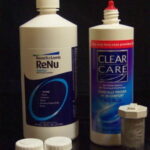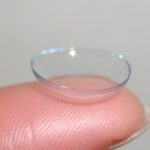Contact lenses are a popular form of eye correction. As long as users are careful about the proper care of their lenses, contact lens wear is generally “safe”.
Nevertheless, from time to time, complications from contact lens wear will occur. In the recent years, we have seen in the news some of the serious sight threatening infections associated with certain contact lenses and solutions used by patients. Here is a brief guide to six potential problems that can occur to the contact lens wearer.
Infectious keratitis (Corneal Ulcers)
This is a dreaded complication where a breach in the epithelial surface of the cornea allows germs to penetrate into the deeper layers of the cornea resulting in pain, redness, foreign body sensation and photophobia. Urgent treatment by an ophthalmologist is necessary. Contact lens wear should be ceased immediately.
The ophthalmologist may send corneal scrapings to the laboratory for culture and sensitivity following which antimicrobial treatment will be commenced immediately.
Daily review of the patient’s condition is indicated until the corneal ulcer resolves. Because these ulcers often heal with scarring, central lesions may result in a reduction of vision. In extreme cases, where the cornea thins out due to infection, perforation of the cornea can occur. A corneal transplant may be indicated in severe cases.
Infectious conjunctivitis
As contact lenses are in direct contact with our eyes, they can act as a vehicle for germs e.g. viruses, bacteria, and fungi to enter the eye in some form of the other. This could be from poor hygiene or using contaminated solutions. There is redness of the affected eye associated with tearing and eye discharge. This condition is usually painless and therefore if there is severe pain, other conditions should be considered e.g. corneal ulcers.
Conjunctivitis can be treated with antibiotic eye drops and is usually a self limiting condition. Any contaminated solutions or contact lenses should be immediately discarded so prevent recurrent infection. Contact lens wear should be stopped until the infection is cleared.
Giant Papillary Conjunctivitis
This is an allergic reaction of the superior conjunctival tarsal plate. Papillae >1mm are present. It is more common in soft contact lens wear, compared to rigid lens wear.
Contact lens wearers may find increased movement of the lens, mucus in tears and protein deposition in the lens surface. They will also find that their eyes may be frequently itchy and red.
The treatment of this includes optimizing lens hygiene and reducing the wearing time of the lenses. The fit of the contact lens should be examined. Lenses that have excessive edge lift may traumatize the tarsal surface. A change to RGP lenses may sometimes solve the problem as these are smaller in diameter.
Sodium cromoglycate and some antihistamine eyedrops have been effective in this condition. Long term steroid therapy should be avoided because of the hazards of these are greater (e.g. steroid induced glaucoma) than the condition being treated.
Blepharitis
Blepharitis is due to inflammation of the eyelids and or margins. Chronic staphylococcal infection is a common cause of this. Signs include redness around the lid margins.
On close microscopic examination, there is matting or flakes around the base of the eyelashes. The cornea may have some staining on it with greasy and particulate tear content. Some patients may be asymptomatic where as others complain of itchiness, redness and lens intolerance.
Treatment includes eyelid scrubs. Patients should ensure that their eyelids are clean before persisting with contact lens wear. Antibiotics may be required to eliminate chronic infection.
Eyes become drier especially after a long period of contact lens wear. This may be associated with exposure to dry environments e.g. air conditioning, or with work practices e.g. computer work. The drying surface is associated with redness of the conjunctiva, foreign body sensation and reflex tearing.
The symptoms of dry eyes can be relieved by reducing the wearing time and changing the contact lens to a lower water content one. Lubricating eye drops can be used to relieve the symptoms, however not all eye drops are safe to instill while the contact lens is still in the eye.
It is best to see an ophthalmologist who can advise on the appropriate lubricant that will suit the patient and is safe to instill. Punctal plugs is a newer treatment option that is now available.
Solution hypersensitivity, solution toxicity
Certain preservatives in solutions e.g. thimerosal can cause a hypersensitivity reaction. This sensitization may take months or years. This presents with bilateral red eyes and there may be corneal infiltrates.
Now the incidence of getting hypersensitivity is lower as thimerosal is rarely used in contact lens solutions. Treatment includes avoiding thimerosal in solutions, taking off the contact lenses until the infiltrates resolve. Using daily disposable contacts is another option to avoid solution hypersensitivity.
Solution toxicity is another complication of contact lens wear. There is localized disruption of the corneal epithelial surface due to toxic effects of solution components e.g. hydrogen peroxide, thimerosal, benzalkonium chloride, chlorhexidine and polyquad.
The effects are linked to the concentration and dosage of the solution used. This usually develops some months after contact lens wear and is evidenced by superficial punctate keratitis. The patient will experience stinging or burning at the time of inserting the lens.
The incidence of this can be reduced by using non-preserved solutions. Rinsing the lens with saline prior to insertion can also help by washing away the solution. The use of daily disposables can also minimize the risk of solution toxicity.
Patient should always seek early treatment for their eyes if they should develop any complications from contact lens wear from an ophthalmologist.




